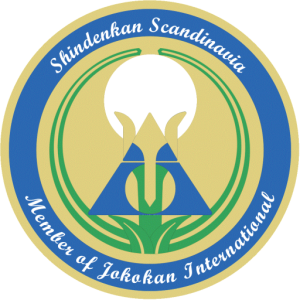By Martin E. Hansen, Member until 2018
A Friday evening in November – the dark time. What is the best thing you can do for yourself? Is it stretched out on the divan with a bowl of Friday sweets and Netflix on the screen? Possibly, but not in Shindenkan, you feel good about yourself when you do something good for yourself = Katafit. Once again, the KataFit course was a big hit both for the Shindenkans themselves, but also for external friends of the Shindenkan who had also chosen to participate this Friday evening.
Jens Hanshi-dai, flanked by Søren Renshi and Martin Renshi, opened the course with a presentation of the seminal KataFit course, which is firmly rooted in the Shindenkan curriculum and the first mandatory course that all Shindenkaners encounter on their journey through the comprehensive curriculum of Yakami Shinsei-ryu . When it is first on the competence plan for the individual practitioner, it is because it is very important for the understanding of the body as a whole and correct breathing, and thus the individual practitioner gets the best possible prerequisites to get the best out of the future training in Yakami Shinsei-ryu. The 50 participants listened intently and raised some good questions, which Jens Hanshi-dai answered with great enthusiasm. Especially when the presentation touched on the yield and result of the global launch and testing of KataFit, attention was sharpened. KataFit has produced good results in injury rehabilitation in otherwise, by the modern medical profession, "impossible cases". Nothing is impossible in Kimu Sensei's eyes, which is reflected in the strong set of values of Shindenkan and in particular through action in KataFit.
After the approx. half an hour's presentation, the participants were divided into 3 groups so that they could get optimal focus and teaching through the practical part of the course – one group of adults/JokoTeens and 2 groups of JokoKidz. Kimu Sensei's philosophy is a constant spiral of improvement, which can easily take place even if the knowledge is 1000 years old and man has not changed for much longer, but he has communication, communication and attitude that follow the trends of the time. Therefore, it is always adjusted for the better through feedback from participants and instructors on previous courses, which is also reflected here on the website in the extensive knowledge forum and all the articles over time. Jens Hanshi-dai got down to business with MMBH, which is the abbreviation for the beneficial whole-body stretching exercises (which are much more than stretching exercises) that introduce KataFit. Many of the participants at KataFit were completely new to Shindenkan, so MMBH alone was already a challenge, but also a good experience "Do I have a muscle there?" "Damn it, can men also get hurt there?" - yes, the thoughts and comments were both funny, redemptive and surprising 🙂
A total of 2.5 hours, it took approx. to get through the whole KataFit, after which a full KataFit 1S was run. The training took place at a pace where everyone could follow along and dwell on the important details that form the basis of a properly executed KataFit, which looks like a very different workout from the outside. But nothing, absolutely nothing, is left to chance, which the participants also had to prove by repetition upon repetition, which is necessary to learn KataFit correctly. The "exercise" is precisely called Kata because there must be flow, breathing, attitude, etc., as in any other optimally performed kata in Yakami Shinsei-ryu. KataFit is divided into the four main groups BackFit, FrontFit, CoreFit and LowerCrossHit, each of which overlaps with each other and builds up to a climax, also cardio vascular, in Lower Cross Hit. The participants went through all the techniques and opened their eyes to a lot of muscles, tendons, ligaments and nerves that they had no idea they had or had trained before. It provides increased body awareness, which is also one of the main purposes of KataFit and an essential leg of Yakami Shinsei-ryu. Therefore, it was also with a good kind of fatigue, muscle soreness and buzzing in the body that most people left the course with. The bonus was also the mental fatigue, as KataFit not only trains the physical part, but just as much the psychological part, starting with comfort zones, awareness of one's own ability, attitude, etc. If you looked at the facial expressions alone, the course was a great success, but I wonder the dividend for the individual is also reflected accordingly. In all cases, everyone left the course with the prerequisite to maintain KataFit both at home and in the local schools, and thus with the hope of being able to maintain a healthy body and soul for many years to come, physically and mentally.




